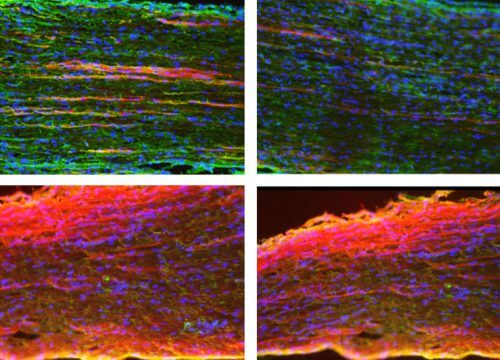The discovery may lead to the development of targeted treatments to heal injuries in the peripheral nervous system, and perhaps in the future even in the central nervous system

Regrowth of nerve cell extensions surrounded by glial cells (cell nuclei are marked in blue), in the sciatic nerve of a mouse, seven days after injury (top) and 25 days after it (bottom). In mice without Silc1 (left column), the restoration is less powerful - the regrown nerve cell extensions (red) are shorter than in mice with an active Silc1 copy. Photographed using a fluorescence microscope
Genes encoding proteins mostly work simultaneously in different tissues and in diverse situations, therefore increasing or decreasing their activity may cure a disease in one organ, but cause unwanted side effects in other organs. In contrast, genes that do not code for proteins but are transcribed into control molecules, called long non-coding RNA molecules (long non-coding RNA) or lncRNA for short, have a narrow specialization - they are expressed in specific tissues and under well-defined circumstances. Weizmann Institute of Science scientists recently identified a lncRNA gene that plays a crucial role in nerve cell repair. This discovery, which was reported in the scientific journal Molecular Cell, may lead to the development of targeted treatments to heal injuries in the peripheral nervous system, and perhaps in the future even in the central nervous system.
Because lncRNA genes do not code for proteins, scientists have ignored them for many years. Only in the last decade were these genes discovered as important control agents of the genome. For example, they are involved in the control of cell formation and their division during the development of the fetus and also in the adult body. "There are more than 20 lncRNA genes in the human genome - perhaps even more than protein-coding genes - but so far we have only discovered the role of a handful," says the head of the research group, Dr. Igor Olitsky from the Department of Biological Control.
Dr. Olitsky and his group members - Dr. Ratem Ben-Tov Perry, Hadas Hezroni and Micah Goldrich - investigated the roles of lncRNA in the peripheral nervous system of mammals, where a particularly wide variety of these non-coding genes is expressed. When nerve cells in the hands, feet and the rest of the peripheral nervous system are damaged, they regrow their extensions - this is in contrast to the central nervous system, i.e. the brain and spinal cord. The reason for such a different behavior of the nerve cells in each of the systems is not clear, especially in light of the fact that both have similar growth mechanisms during embryonic development. Dr. Olitsky and his colleagues tested whether the lncRNAs might contribute to solving this mystery.
The self-healing of nerve cells in the peripheral nervous system is not perfect and takes a long time. It is possible that in the future it will be possible to develop treatments that will speed up the recovery"
From the right: Dr. Igor Olitsky, Micha Goldrich and Dr. Ratem Ben-Tov Perry. "narrow specialty"
To this end, the scientists conducted a genetic mapping of mice with a sciatic nerve injury. They found that about a week after the injury, when the nerve began to regenerate, expression of a certain lncRNA jumped tenfold. The scientists also discovered that this gene - which they named Silc1 - initiates a healing program in which a nearby gene is activated, which is known to play a role in the regrowth of nerve cells only.
The scientists then performed a series of experiments that established the central role of Silc1 in the regrowth of nerve cells: when they increased the expression of Silc1 in nerve cells in culture, the growth increased by 40% compared to normal nerve cells; In contrast, when the scientists blocked the expression of Silc1 in transgenic mice, the regeneration of the damaged sciatic nerve was less efficient and slower than in non-transgenic mice. The importance of Silc1 is also expressed by the fact that it is one of the relatively rare lncRNAs - in total, there are about 1,000 of them - that have been preserved throughout evolution and are found in all mammals, including mice, rats and humans.
Further experiments showed that Silc1 has a particularly "narrow specialization": it is expressed only in a mature organism, only after injury in peripheral nerve cells - and only in those covered by a protective myelin layer. This specialization may allow the development of treatments targeted at damaged nerve cells that will not cause side effects in other tissues. "The self-healing of nerve cells in the peripheral nervous system is not perfect and takes a long time - for example, the rehabilitation period after an injury to the sciatic nerve, the widest and longest nerve (about 100 cm long) in the human body, may last an entire year," says D. R. Olitsky. "It is possible that in the future it will be possible to develop treatments that will speed up recovery." The discovery of the gene may also open a new direction of research towards the possibility of curing damage to the central nervous system. In these studies it will be necessary to check whether the expression of Silc1, or an action simulating this expression, can help damaged nerve cells, for example in the spinal cord, to regrow.
